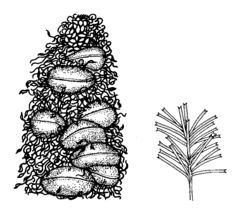Common name: Heath-leaved Banksia, Wadanggari (Cadigal)
Banksia ericifolia L.f. APNI* 
Description: Tall bushy shrub or small tree to 6 m high, without lignotuber, single-stemmed at base; bark ± corky, grey-brown; branchlets smooth with lenticels.
Leaves alternate, crowded, linear, 0.9–2 cm long, often c. 1 cm long and 1 mm wide, apex truncate or notched with a small tooth at each side, base attenuate, margins revolute, entire; lower surface tomentose; ± sessile.
Conflorescences usually 10–20 cm long. Perianth 16–28 mm long, golden-brown, often mauve towards base, persistent. Style hooked below apex, gold to orange-red, persistent.
Follicles many, ± oblong, c. 15–20 mm long, the upper surface convex, prominently ridged on each side; usually opening with fire.
Flowering: Flowers April–August
Distribution and occurrence: Grows in heath, dry sclerophyll forest and woodland, widespread on the coast and ranges, from Jervis Bay to the Qld border.
NSW subdivisions: NC, CC, SC, CT, ST
Text by G.J. Harden
Taxon concept:
| | Key to the subspecies | |
| 1 | Seedling leaves with 2–6 teeth on each margin; perianth 19–22 mm long, limb pubescent. Gynoecium 30–35 mm long | subsp. ericifolia |
| Seedling leaves with 1, rarely 2 teeth on each margin; perianth 25–28 mm long, limb hirsute. Gynoecium 46–48 mm long | subsp. macrantha |
APNI* Provides a link to the Australian Plant Name Index (hosted by the Australian National Botanic Gardens) for comprehensive bibliographic data
***The AVH map option provides a detailed interactive Australia wide distribution map drawn from collections held by all major Australian herbaria participating in the Australian Virtual Herbarium project.
|


